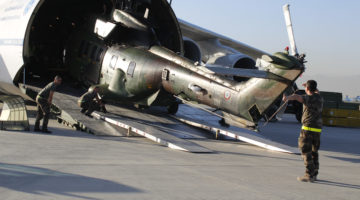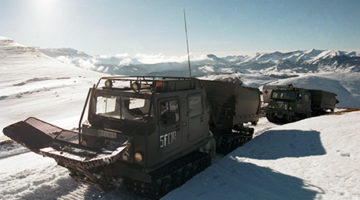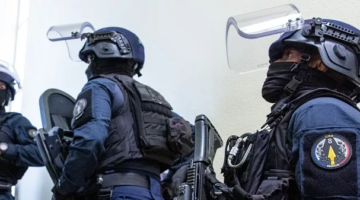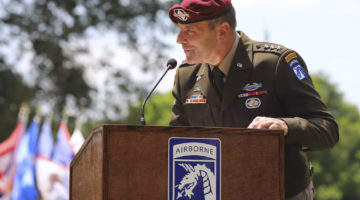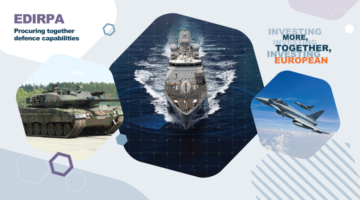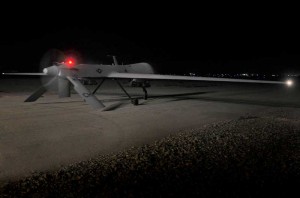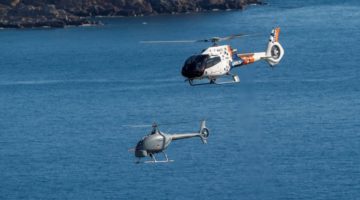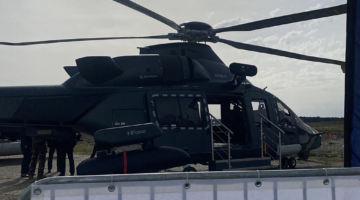Photo credit © 407th Expeditionary Group Public Affairs / MQ-1 in Iraq
The Centre for Military Studies, Department of Political Science of the University of Copenhagen, published two pieces earlier this year addressing the question of the potential role of large unmanned aerial vehicles for Danish security and defense forces in the years ahead.
The reports provided an especially useful look at evaluating the actual performance of larger UAVs seen from the perspective of a smaller ally who needs to be concerned with both effectiveness of anything they buy and value proposition.
The reports shed important insights on both aspects: effectiveness and the value of larger UAVs. It is not a question of smaller UAVs, which the Danes have been using since 1958; it is a question of Predator or Global Hawk class drones.
Although Denmark is a small country, its forces are expeditionary in character. And when the Kingdom of Denmark is considered, the ISR and C2 coverage is a significant challenge as well.
Denmark’s territory is 16,639 sq. miles (43,094 km²). But the Kingdom of Denmark is of a different character entirely: 2,210,579 km² or 853,509 sq. miles.
And with the Arctic opening, ISR and C2 over a vast area is a significant consideration for the Danes. And the area in question is largely a maritime domain with little land-based infrastructure to provide ISR and C2 compensation for what can be generated from air, sea and space.
Clearly one issue to be sorted out is how Denmark which is responsible for security and defense for the Kingdom is going to pay the costs for such as the Arctic opens. Clearly, money needs to be generated from the various commercial ventures in the region and the increased revenue, which the Faroe Islands and Greenland will receive.
The reports take a hard look at the actual cost and performance of Predators and Global Hawks to determine their relevance to Denmark of procuring and operating a similar capability on their own. The authors of the reports do not buy into UAV-mania whereby unmanned is the future of airpower; rather they look at how large UAVs actually have fit into the kinds of operations Denmark needs to do.
The reports underscore that large UAVs are costly, manpower intensive to operate (notably when data exploitation is added in), crash at a significantly higher rate than manned assets, require significant training of the forces to use the UAVs, and have been successfully largely because they have operated in an air dominance environment.
The Danish experience with the Sagem UAV was also a benchmark for how not to acquire UAVs. The experience led Denmark to sell their systems to the Canadians, and to exit from the French provided assets. A main reason for the failure was buying a developmental system, but also significantly underestimating the importance of a trained cadre of UAV operators and users.
But what about UAVs for Denmark’s Arctic mission ? The problem here is the question of the durability of UAVs in such a harsh environment. The conclusion is pretty clear-cut: Buying and operating large UAVs does not make a lot of sense for Denmark. But working in a coalition is a better alternative.
Denmark is now participating in the NATO AGS system, and the authors of the report recommend leveraging this experience. There is also a clear interest in shaping a coalition consortium where data could be leased from Global Hawks, e.g.
Lt. General (Retired) Deptula, a major force in US ISR innovation, has argued for some time that the U.S. needs to shape a coalition enabled data sharing and leasing strategy. This way the costs of the platforms are amortized across a coalition without any individual coalition partner having to pay up front for the UAV.
The report is really about UAVs, but another consideration for the Danes might be looking at a package of ISR and C2 assets within which UAVs might operate.
Leasing assets from space such as with the RADARSAT, leveraging the ISR and C2 capabilities of the F-35 (if Denmark procures the aircraft), augmenting patrol craft capabilities, such as roll-on-roll off ISR and C2 packages on their C-130s, and leveraging a Nordic or Arctic coalition set of UAVs might make a lot of sense for Denmark.
The reports can be found here on the Centre for Military Studies website:
The first report can be downloaded here as well :
Unmanned and Unarmed: On the Future use of Unmanned Aerial Systems in the Danish Armed Forces
The synopsis of the report follows :
Unmanned aerial vehicles (UAVs) are being integrated into the military forces of Western states, including Denmark. How should the Danish government proceed when considering investments in UAVs? Although airpower and UAVs have substantially shaped the Western paradigm for the use of force, the American, British, French, and Danish experiences highlight difficulties developing, acquiring, and operating UAVs. The Danish government should consider the tasks that UAVs are best-suited to perform, the costs associated with the entire UAV system, and the operational, doctrinal, and other challenges that must be addressed to integrate UAV capabilities into the Danish armed forces.
These are not trivial considerations.
Larger UAVs are very complex systems with which the Danish armed forces have limited experience, and introducing radically new technology always comes with substantial risks. Should Denmark decide to procure larger unmanned systems, such as Reapers or Global Hawks, it should cooperate with Allies to purchase, operate, and integrate these capabilities as smoothly as possible and mitigate these risks.
It should also establish a joint unit dedicated to house, train, educate, and operate UAVs within the armed forces, cooperate with domestic agencies that may desire the information that UAVs can provide, and consider shaping the domestic and international regulatory environment that will constrain UAV use for the foreseeable future.
The key recommendations of the report for Denmark is as follows:
Preparing for a Decision :
• Stand-up a dedicated UAV-unit in Danish Defence Command—perhaps dovetailing the “Future Fighter Aircraft” team, to consider the role of unmanned systems in Danish airpower.
• Maintain or increase participation (in terms of personnel) in NATO’s AGS system as it becomes operational to expand the Danish knowledge base.
• Follow UK and NATO attempts at certifying systems for wider use in civilian airspace to facilitate their peacetime and dual-use roles.
• Actively support efforts by national and international aviation authorities to establish solid regulations for the use of UAVs in civilian airspace.
• Engage potential partners for procurement and/or operations early and informally, but in detail.
• Piggyback to the widest possible extent on experiences and lessons of comparable partners and allies already operating UAVs.
• Considering modularity—more potential configurations—means more kinds of missions. This is currently how the manned Challenger system works. But modularity also incurs higher expenses and system risk.
• Continue tests and experiments—both in the Arctic and non-Arctic parts of the Kingdom—and involve potential partners in these to create the basis for discussing future joint requirements.
• Software and sensor-packages are crucial for the capability a system will be able to deliver. These are equally expensive and can account for a substantial part of the price of a system.
In Deciding
• Have a clear definition of tasks and consolidated concepts of operations ready.
• Ensure a clear command structure for procuring, certifying, manning, and operating the system.
• Engage other government agencies. UAVs can produce data for many potential users.
• Will Danish UAVs only be a military capability? With expected regulative changes, civilian governmental demand will rise, and with that also the potential for sharing expenses.
• Continue to seek partners and work for synchronicity in when and what to procure, even if it might mean compromising on system requirements or the defence planning process.
In Initial Operations
• Contemplate whether, for an initial start-up period, operations should be conducted from an experienced Allied user’s facilities to reduce risk and increase everyday access to knowledge and expertise (as the UK has done).
• Trained personnel, infrastructure, and organization must be in place and be robust at an early stage.


